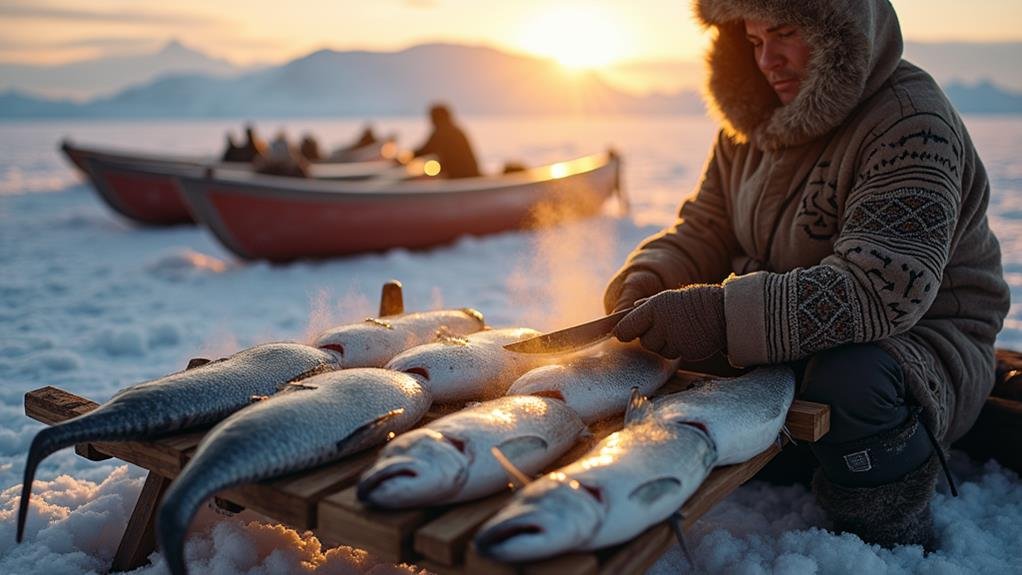In the unforgiving Arctic landscape, where temperatures plummet to deadly extremes and daylight plays hide-and-seek for months, Inuit communities haven't just survived—they've mastered the art of adaptation. Their remarkable blend of ancestral wisdom and cutting-edge technology creates a powerful framework for resilience that's caught the attention of climate scientists worldwide. While traditional hunting methods persist alongside GPS tracking and satellite phones, it's the seamless integration of old and new that sets their approach apart. The story of Inuit adaptation offers valuable insights into how humanity might face an increasingly unpredictable climate future.
Main Points
- Traditional hunting methods combined with modern technology like the SIKU app enhance safety and efficiency in Arctic survival.
- Specialized tools and equipment, from ancient harpoons to modern gear, enable successful hunting and navigation in extreme conditions.
- Sustainable resource management practices ensure complete utilization of harvested animals and long-term food security.
- Community-based knowledge sharing systems facilitate rapid adaptation to changing environmental conditions through collaborative decision-making.
- Traditional ecological knowledge passed through generations guides conservation while adapting to climate change challenges.
Traditional Knowledge and Modern Technology
The Inuit's masterful blend of ancestral wisdom and modern innovation exemplifies their remarkable adaptability in the Arctic. Traditional knowledge passed down through generations, such as interpreting animal behavior patterns and seasonal variations, now works seamlessly with cutting-edge tools like GPS systems and satellite technology to enhance hunting success and safety.
Inuit communities have embraced this technological evolution while maintaining their cultural practices. The SIKU app represents a perfect example of this integration, combining traditional knowledge with modern technology to create a digital platform where hunters share critical information about ice conditions and wildlife movements in real-time. This innovative approach helps maintain safety and efficiency during hunting expeditions.
As climate change continues to transform the Arctic landscape, Inuit communities are leveraging both their ancestral understanding and contemporary solutions to adapt. They're actively participating in collaborative research projects that merge Indigenous expertise with scientific data, creating thorough strategies for survival in their changing environment. This dynamic approach guarantees the preservation of traditional practices while embracing technological advances that enhance their ability to thrive in extreme conditions.
Arctic Survival Strategies
While Arctic environments present formidable challenges, Inuit communities have mastered an intricate set of survival strategies that span generations of practical experience. Their traditional knowledge of seasonal patterns and wildlife movements has proven vital for successful hunting and resource management in these extreme conditions.
Key elements of Inuit Arctic survival include:
- Specialized tool development, including harpoons and kayaks, which enhance hunting efficiency
- Sustainable use practices that utilize every part of harvested animals, from meat for food to bones for tools
- Community-based decision making that guarantees knowledge sharing and resource distribution
The Inuit's adaptation strategies seamlessly blend ancestral wisdom with modern innovations. They've maintained their traditional knowledge while incorporating contemporary tools like the SIKU app for safer ice navigation. This dynamic approach to survival demonstrates their remarkable ability to evolve while preserving essential cultural practices. Their sustainable use of resources, coupled with collaborative social structures, creates a resilient system that's withstood centuries of environmental challenges. These time-tested methods continue to prove effective in maintaining their communities' survival and cultural identity in the harsh Arctic landscape.
Environmental Stewardship

Building upon their survival strategies, Inuit communities have emerged as exemplary environmental stewards of the Arctic region. Their traditional ecological knowledge, passed down through generations, guides sustainable resource management practices and helps them adapt to rapidly changing climate conditions. This deep understanding of the environment is evident in their waste-free approach to hunting, where every part of an animal serves a purpose, from food to tools and clothing.
The Inuit's environmental stewardship extends beyond individual practices to encompass community-wide initiatives. Their collaborative decision-making processes guarantee that resources are shared equitably while maintaining ecological balance. Recent technological adaptations, like the SIKU app, demonstrate how Inuit communities are bridging traditional knowledge with modern tools to enhance their environmental monitoring capabilities.
Despite their strong conservation ethic, challenges remain in protecting Arctic ecosystems. The current coverage of Marine Protected Areas at 4.7% falls short of international targets, highlighting the need for increased conservation efforts. However, Inuit communities continue to advocate for expanded protections while maintaining their role as guardians of the Arctic environment.
Cultural Preservation Through Change
Throughout centuries of change, Inuit communities have masterfully balanced cultural preservation with adaptation, demonstrating remarkable resilience in maintaining their identity while embracing new realities. The indigenous people's commitment to cultural preservation is evident through organizations like the Inuit Tapiriit Kanatami, which champions the protection of their heritage and language.
Traditional knowledge continues to shape modern Inuit practices in three distinct ways:
- Sustainable resource management, blending ancestral hunting methods with contemporary tools
- Innovative adaptation of traditional clothing, incorporating modern materials while maintaining cultural significance
- Language revitalization efforts, focusing on preserving Inuktitut and related dialects
The integration of new materials and techniques into traditional practices showcases the Inuit's dynamic approach to preserving their culture. Community gatherings and seasonal festivals remain crucial platforms for transmitting knowledge and strengthening cultural bonds. Through these celebrations, elders share traditional knowledge with younger generations, ensuring the continuity of Inuit customs. This blend of traditional wisdom and modern adaptation demonstrates how cultural preservation can thrive amid environmental and social changes while maintaining authentic indigenous values.
Sustainable Resource Management

The Inuit's sustainable resource management system represents one of humanity's most sophisticated examples of environmental stewardship. Their approach to hunting exemplifies this, as communities utilize every part of harvested animals – from crafting tools out of bones to fashioning waterproof clothing from seal guts. This waste-free practice demonstrates their deep understanding of resource conservation and respect for wildlife.
At the heart of their system lies the concept of food sovereignty, which they've maintained through generations of traditional ecological knowledge. The Inuit's expertise in seasonal patterns and animal behavior has led to the development of efficient hunting methods that guarantee long-term resource availability. They've successfully adapted these practices to modern challenges through innovations like the SIKU app, which enhances safety and resource tracking.
Their commitment to conservation is further evident in Inuit-led marine conservation initiatives, particularly the establishment of Marine Protected Areas. These projects blend traditional wisdom with contemporary conservation strategies, creating a balanced approach to resource management that protects critical marine habitats while maintaining cultural practices. This integration of old and new demonstrates the Inuit's adaptive capacity in preserving their resources for future generations.
How Have Inuit Adaptations Assisted in Their Contributions to Arctic Exploration and Scientific Discoveries?
Inuit adaptability to harsh Arctic conditions has been crucial in guiding explorers and researchers. Their knowledge of survival techniques, weather patterns, and using natural resources has played an essential role in inuit arctic exploration, allowing scientists and adventurers alike to make groundbreaking discoveries in one of Earth’s most challenging environments.
How Has Inuit Clothing Evolved as Part of Their Adaptation to Harsh Arctic Environments?
Inuit clothing and adornment have evolved over centuries to offer essential protection against the extreme cold of the Arctic. Made from animal skins and furs, these garments trap body heat while remaining breathable and flexible. Today, modern materials blend with traditional designs, reflecting enduring cultural identity and environmental adaptation.
Conclusion
The Inuit's remarkable fusion of traditional wisdom and modern innovation has proven essential for Arctic survival. Today, over 75% of Inuit hunters actively use digital tools like the SIKU app alongside ancestral knowledge for safer navigation. They've maintained their cultural identity while adapting to environmental challenges, demonstrating that sustainability isn't about choosing between old and new – it's about creating resilient solutions that honor both.


